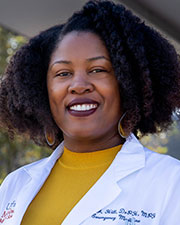Takeaway
As a part of every patient encounter, I ask myself how I can ensure that they have a positive experience. This begins with recognizing the patient as a person.

Connecting with Patients | August 21, 2023 | 2 min read
By Mandy Hill, DrPH, MPH, UTHealth Houston, McGovern Medical School
After screening the patient’s electronic medical record, I went to her room to ask about her willingness to participate in a sexual health research study. The patient was a young Black woman actively experiencing a miscarriage. The room was dark, and the patient was lying on her side with her back to the door. I asked her if it was ok to have a conversation about a research study. She expressed a sincere interest in learning more. We discussed my research and as we talked, her pain intensified. We worked together to release the gel in the heating pad. After several tries, I went to the door to get nursing support and the internal parts in the heating pad burst, giving her relief. We continued to talk, and she gave her informed consent and was enrolled in the study. As I left her room, she thanked me for coming to talk with her. She expressed appreciation for my sincere concern for her health and well-being, which made her feel truly seen as a human.
Most healthcare professionals have spent time in a cadaver lab. In each body, evidence of blood traveling from lungs to the left atrium is present. Every human brain contains billions of nerve cells arranged in patterns that coordinate, thought, emotion, behavior, motions, and feelings. On some level, healthcare professionals understand that race, ethnicity, gender identity, sexual orientation, height, weight, hair color, et cetera, don’t tell the whole story.
With this deep understanding of sameness, every healthcare professional and trainee should come to patient care with a moral compass that guides their intrinsic motivation to do what is right for every patient. Before entering your next patient’s room, reflect and consider:
1. What can I do to increase the likelihood that my patient will walk away from this experience feeling that I see and respect their humanity?
2. What should I notice BEYOND the symptoms? What social determinants of health are at play? How do these factors impact their health?
3. Who is this patient as a person?
4. What is the lived experience of this patient? How should I consider this experience when making behavioral recommendations, like the likelihood of them taking their medication correctly?
When you leave that patient’s room, ask yourself, “Did I do my best to meet this patient’s needs? Did I offer them the best care options within the reach of their resources and normative behaviors?”
Every patient in every encounter is a reflection of the healthcare professional’s commitment to live an exemplary personal and professional life, as described in the Hippocratic Oath.
This piece expresses the views solely of the author. It does not necessarily represent the views of any organization, including Johns Hopkins Medicine.

